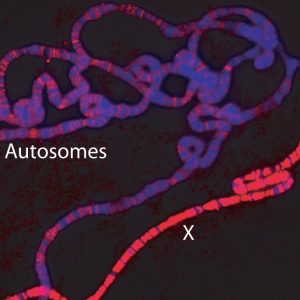X chromosome exposed
An enzyme that binds differently to male and female sex chromosomes helps males to make up for their X chromosome shortage

Researchers from the European Molecular Biology Laboratory (EMBL) in Heidelberg, Germany, and the EMBL-European Bioinformatics Institute (EMBL-EBI) in Hinxton, UK, have revealed new insights into how sex chromosomes are regulated. A chromatin modifying enzyme helps compensate for the fact that males have only one copy of the sex chromosome X, while females have two. The enzyme distinguishes between male and female sex chromosomes in fruit flies and binds to different locations on the male and female X chromosome, the scientists report in the current issue of the journal Cell. The evolutionarily conserved enzyme is also found in humans.
In species ranging from insects to humans, sex chromosomes, the famous X and Y, are responsible for determining gender. Females have two copies of the X chromosome while males have one X and one Y. This could mean that females produce twice as many proteins from the genes carried on the X chromosome as males. However, fruit flies compensate for the sex chromosome difference by doubling the activity of genes on the X chromosome in males – a vital process called dosage compensation. Biologists already know that a molecular machine called the MSL complex achieves dosage compensation in flies, but it remains unclear how exactly it accomplishes its function. Now researchers from the lab of Asifa Akhtar at EMBL and the groups of Nick Luscombe and Paul Bertone at EMBL-EBI have uncovered how one component of the MSL complex, an enzyme called MOF, ensures that the activity of only male X chromosome genes get ratcheted up. MOF relaxes the structure of chromatin – tightly packaged DNA, to allow the transcription machinery to access genes on the DNA.
“We were very surprised to find MOF bound not only to the X chromosome in males, but also to all the other chromosomes in the nucleus. This suggests the enzyme as a universal regulator of transcription that has evolved to play a specific role in dosage compensation,” says Akhtar.
A closer look revealed that MOF binds differently to chromosomes from males and females. On autosomes, chromosomes that are not involved in determining sex, and the X chromosome in females, MOF binds mostly to the beginning of a gene where transcription starts. On the X chromosome in males, however, MOF binds also towards the end of the gene. Most likely MOF opens up the DNA towards the end of the genes and ensures that transcription is completed successfully.
“One can imagine the transcriptional machinery moving along the DNA like a train on a railway track. When the tracks are blocked the train could derail, resulting in incomplete transcription,” explains Juanma Vaquerizas of Luscombe’s lab, who contributed to the analysis of Akhtar’s data. “It appears that MOF clears the tracks throughout the male X chromosome, while on a female X obstructions are more likely to occur.”
More complete transcription results in more proteins produced from the single X chromosome in males than from either of the two X chromosomes in females, thereby balancing out their excess.
MOF is the first enzyme in the MSL complex to behave differently according to whether the target gene is located on the sex chromosome versus other chromosomes in males.
“MOF is conserved across species and also has a human homolog. Since the mechanism of dosage compensation is radically different in mammals, it will be very interesting to discover what functional role this enzyme might play in that context,” says Bertone.



